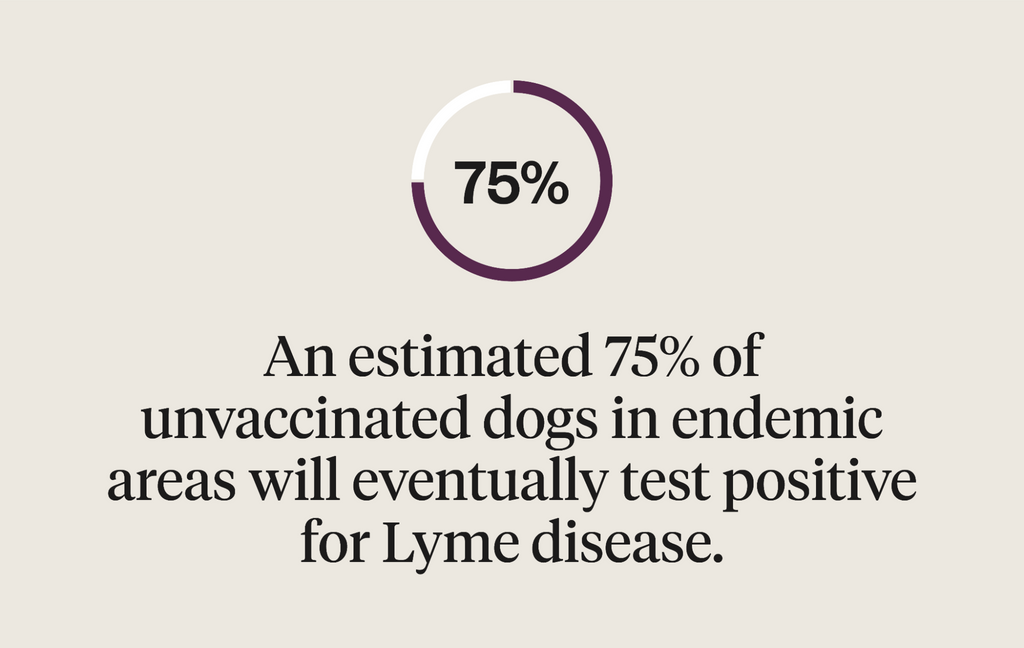8 Min Read
April is Prevent Lyme in Dogs Month
Key takeaway

Why pet owners are switching to online vet care with Dutch
-
Prescriptions delivered free to you
-
Fast access to Licensed Vets over video
-
Unlimited video visits and follow-ups
Lyme disease is a tick-borne disease that’s caused by Borrelia burgdorferi (B burgdorferi), a type of bacteria that some ticks carry. While many dogs who are exposed to Borrelia burgdorferi don’t experience the effects of Lyme disease, it can be a serious condition if you don’t catch and treat it early on.
April is Prevent Lyme Disease in Dogs Month, an annual awareness month that was created by the Lyme Disease Foundation. Prevent Lyme in Dogs Month is an opportunity for pet lovers everywhere to spread awareness about Lyme disease and how to prevent Lyme disease in dogs.
With April approaching fast, it’s the perfect time to learn more about Lyme disease in dogs. You can read this post from start to finish for a comprehensive overview of Prevent Lyme Disease in Dogs Month, or you can use the links below to jump ahead to a specific section.
- What is Prevent Lyme Disease in Dogs Month?
- The Importance of Flea Prevention in Dogs
- When is Tick Season?
- How to Prevent Lyme Disease in Dogs
- FAQs
- Final Notes

What is Prevent Lyme Disease in Dogs Month?
Prevent Lyme Disease in Dogs Month is a month that’s dedicated to spreading awareness about Lyme disease and Lyme prevention for dogs. Unfortunately, Lyme disease is fairly common in canines. If you live in a rural area where ticks are more common, Lyme disease prevention for dogs is even more important.
Approximately 75% of unvaccinated dogs in endemic areas will eventually test positive for Lyme disease
Lyme Disease Prevention Month takes place in April because dogs are at higher risk for Lyme disease during the spring and summer. With the weather warming up, tick prevention is especially important.
During Prevent Lyme Disease in Dogs Month, experts spread awareness by educating people about Lyme disease. If you don’t know what symptoms to look for or how to prevent or treat Lyme disease, this month is an excellent opportunity to learn.
April is also a good time to brush up on ways to thoroughly check for ticks. Ticks partially embed themselves in your dog’s skin, so they can easily be mistaken for a mole or a discolored spot on your dog’s skin. There are also common hiding spots you need to check when you’re checking your dog for ticks.
The Importance of Flea & Tick Prevention in Dogs
Flea and tick medicine are dog care essentials because they can help prevent diseases and other medical conditions caused by flea and tick bites. Generally, flea medicine for dogs is also designed to prevent ticks.
It’s your job as a pet parent to keep your pets safe and healthy, and flea and tick prevention is a key part of that. There are several ways to prevent fleas and ticks, including medication, shampoos, topical applications, and products that are designed to kill the fleas in and around your home.
According to the CDC, there is no evidence that Lyme disease can spread through flea bites. However, administering flea and tick medicine on a regular schedule can help you prevent ticks as well as fleas.
While it appears fleas don’t spread Lyme disease, they can harm your dog in other ways. Severe flea infestations can lead to anemia, especially in small breeds, puppies, or dogs with blood-related health issues. Flea bites can also lead to dermatitis. As far as diseases go, fleas can spread tapeworm and canine Bartonellosis.
When is Tick Season?
Ticks are more common during certain parts of the year, which means flea and tick prevention is especially important during these seasons, though some dogs may benefit from year-round protection.
The bacteria that causes Lyme disease can be carried by black-legged ticks, also known as deer ticks, which are more prevalent during the spring and summer. However, it’s important to keep in mind that the tick season may be extended by a long, warm summer.
If you’re west of the Rocky Mountains, western black-legged ticks are the primary concern. For people in other parts of the US — especially the Northeast — deer ticks are the biggest problem. Ticks are also more common in tall grass and areas with lots of bushes and woods. Small animals like rodents can also bring ticks into your yard.

How to Prevent Lyme Disease in Dogs
Flea and tick prevention is one of your most important jobs as a pet parent. Fleas and ticks can cause a host of health issues — and diseases like Lyme can cause major problems. With Prevent Lyme Disease in Dogs Month approaching fast, here’s what you can do to prevent Lyme.
The best way to prevent Lyme disease in dogs is to prevent and treat fleas and ticks. Make sure you’re giving your dog a flea and tick preventative — following any instructions your vet provides. You should also check for fleas and ticks regularly, removing them if you find any. Keep a glass of hot, soapy water nearby so you can kill any fleas or ticks you remove from your dog.
Keeping up with flea and tick treatments is easy with our online pet pharmacy. You can get the medicine your dog needs delivered to your door so you don’t miss flea and tick treatments. Not sure which flea and tick solution is best for your pup? Take our Flea & Tick Quiz to find vet-recommended options to protect your pet during flea and tick season.
You can reduce fleas and ticks in your yard by keeping the grass short and keeping other animals out. Mow your grass regularly and consider removing plants or trees that attract wildlife in your yard. If you take your dog to a park or field with long grass, check them for ticks when you get home.
If you have any shrubs near your home, consider removing them to keep ticks out of your yard. Removing bushes and other plants can be a tough decision, but it’s worth it when it comes to protecting your pets.
Your vet may recommend vaccinating against Lyme disease if they’re at high risk for Lyme disease. If you live in an endemic Lyme disease area, consider talking to your vet to see if vaccinating your dog is the right solution.
If you find deer ticks or western black-legged ticks on your dog, you should take them to the vet to get a test for Lyme disease. Testing for Lyme disease after potential exposure to B burgdorferi is a key part of Lyme disease prevention for dogs.
FAQs
Can you prevent Lyme disease after a tick bite?
There are ways to reduce the likelihood of Lyme disease after a tick bite, but you should talk to your vet first. Your vet may recommend a small dose of doxycycline for high-risk tick bites — such as western black-legged ticks and deer ticks. If you find a tick on your dog, you should remove it if you can and get your dog tested for Lyme disease. Lyme disease is easier to treat when you catch it early on, so you can prevent severe symptoms by getting a test and starting treatment as soon as possible if your dog has Lyme.
Can a tick live on a dog for a month?
When an adult tick bites your dog and attaches, they typically stay attached for anywhere from 7–10 days. Tick nymphs and larvae can only stay attached to a dog for about 3–4 days. A tick will fall off on its own after feeding for a certain period. That being said, ticks are more likely to transmit any bacteria they’re carrying the longer they stay attached to your dog. Checking for ticks regularly can help reduce the risk of B burgdorferi transmission.
Should I be worried if I found a tick on my dog?
If you found a tick on your dog, see if you can identify it. Deer ticks and western black-legged ticks are the primary carriers of Lyme disease, but dog ticks can cause Rocky Mountain spotted fever. You may also want to take your dog to the vet to get tested for Lyme and other tick-borne diseases. The sooner you diagnose tick-borne diseases, the easier they are to treat.

Final Notes
April is Prevent Lyme Disease in Dogs Month — and now you know how to do that. Ticks are a serious concern for pet parents, especially if you live in an area where Lyme is more prevalent. Fortunately, flea and tick prevention and treatment go a long way when it comes to preventing Lyme disease in dogs.
Keeping your pet healthy and preventing Lyme is easier with a Dutch membership. With our online pharmacy and video vet visits, you can get convenient help from a professional when you need it most. Want to know more about Dutch? Reach out to us to find out more about telemedicine for pets and how it works.
Share
References
-
Centers for Disease Control and Prevention. "Lyme Disease." Centers for Disease Control and Prevention, U.S. Department of Health & Human Services, https://www.cdc.gov/lyme/index.html.
-
Centers for Disease Control and Prevention. "How Lyme Disease Spreads." Centers for Disease Control and Prevention, U.S. Department of Health & Human Services, https://www.cdc.gov/lyme/transmission/index.html.
-
New York State Department of Health. "Lyme Disease Fact Sheet." New York State Department of Health, https://www.health.ny.gov/publications/2825/.
